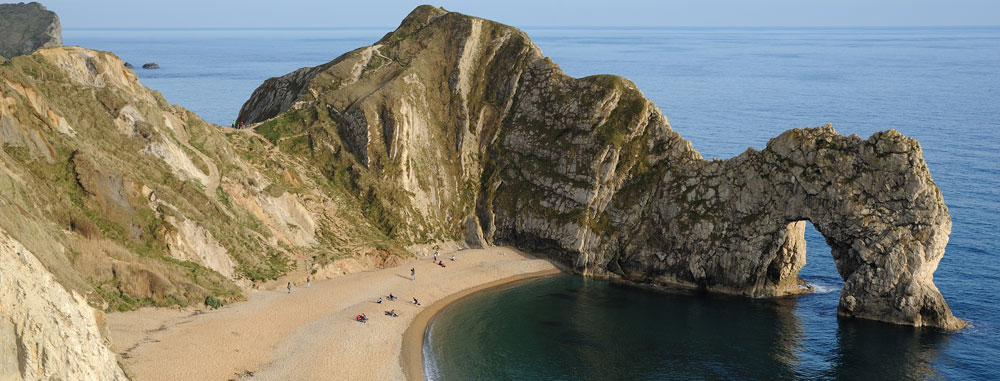
The Jurassic Coast is a UNESCO World Heritage Site on the English Channel coast of southern England. It stretches from Exmouth in East Devon to Studland Bay in Dorset, a distance of about 96 miles, and was inscribed on the World Heritage List in December 2001.

Durdle Door Image by Saffron Blaze via Wikipedia CC BY-SA 3.0
The site spans 185 million years of geological history, coastal erosion having exposed an almost continuous sequence of rock formation covering the Triassic, Jurassic and Cretaceous periods. At different times, this area has been desert, shallow tropical sea and marsh, and the fossilised remains of the various creatures that lived here have been preserved in the rocks.
Natural features seen on this stretch of coast include arches, pinnacles and stack rocks. In some places the sea has broken through resistant rocks to produce coves with restricted entrances, and in one place, the Isle of Portland is connected to the land by a narrow spit. In some parts of the coast, landslides are common. These have exposed a wide range of fossils, the different rock types each having its own typical fauna and flora, thus providing evidence of how animals and plants evolved in this region.
The area around Lulworth Cove contains a fossil forest, and 71 different rock strata have been identified at Lyme Regis, each with its own species of ammonite. The fossil collector Mary Anning lived here and her major discoveries of marine reptiles and other fossils were made at a time when the study of palaeontology was just starting to develop. The Charmouth Heritage Coast Centre provides information on the heritage coast, and the whole length of the site can be visited via the South West Coast Path.
The Jurassic Coast consists of Triassic, Jurassic and Cretaceous cliffs, spanning the Mesozoic, documenting 185 million years of geological history. The site can be best viewed from the sea, when the dipping nature of the rock strata becomes apparent.
In East Devon, the coastal cliffs consist of steep cliffs of red sandstone from the Triassic, and at Budleigh Salterton, the gravel cliffs contain red quartzite pebbles which accumulate on the beach below as Budleigh pebbles, locally protected. Further east at Ladram Bay, more sandstone cliffs give rise to spectacular red sandstone stacks.
Around Lyme Regis and Charmouth the cliffs are of Jurassic clays and shale, and landslips are common. Chesil Beach is a good example of a barrier beach and stretches for 18 mi (29 km) from Burton Bradstock to the Isle of Portland. The beach encloses an intertidal lagoon which is an internationally important Ramsar Convention site known for its biodiversity.
At Lulworth Cove, the waves have cut their way through the resistant Portland stone and created a horseshoe-shaped cove by eroding the softer sands and clays behind. Another feature of this part of the coast is Durdle Door, a natural arch. Sea stacks and pinnacles, such as Old Harry Rocks at Handfast Point, have been formed by erosion of the chalk cliffs.[8]
The highest point on the Jurassic Coast, and on the entire south coast of Britain, is Golden Cap (627 ft (191 m)) between Bridport and Charmouth.
This coast shows excellent examples of landforms, including the natural arch at Durdle Door, the cove and limestone folding at Lulworth Cove and a tied island, the Isle of Portland. Chesil Beach is a fine example of both a tombolo (a deposition landform in which an island is attached to the mainland by a narrow piece of land such as a spit or bar) and a storm beach (a beach affected by particularly fierce waves). The site has stretches of both concordant and discordant coastlines. Due to the quality of the varied geology, the site is the subject of international field studies.
The many sedimentary layers on this coastline are rich with fossils, the remains of the animals and plants present in the area whose tissues became immersed in deposits of mud which later hardened into rock. At Lyme Regis, for example, geologists have identified 71 layers of rock, each one containing fossils of a different species of ammonite.